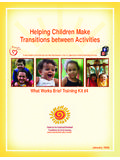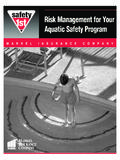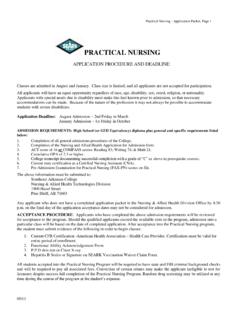Transcription of 2016-2017 Administrator Guide Long Distance …
1 Administrator Guide For additional information, please contact: Trauma Smart Crittenton Children s Center 10918 Elm Kansas City, MO 64134 816-765-6600 Revised 7/18/2016 1 General Overview Purpose The purpose of Trauma Smart (TS) is to help educational organizations create trauma informed communities that support the needs of young children who have experienced trauma and the caregivers (parents, staff ) who love and care for them. Multiple research studies show that early identification and treatment helps mitigate the long term negative health and mental health effects of trauma. Trauma Smart teaches adults to help all children, regardless of trauma histories, to develop healthy resiliency skills that will benefit them over their lifetime. History/Need TS was created in 2008 by Crittenton Children s Center, a non-profit organization in Kansas City, MO.
2 Crittenton provides mental and behavioral health services to children and families through child and adolescent psychiatric hospitalization, residential treatment, outpatient and community-based programs. Crittenton has provided mental health services in schools for over 30 years. From 2004-2007, a single Head Start program in the Kansas City area, serving approximately 800 children, experienced a total of 40 deaths. Some of these were from acute trauma (automobile accidents, tornados, fires, sudden death of parent or staff member). Others were due to chronic, complex trauma (domestic violence, long -term illness, alcohol and drug abuse, etc.) As traumatic events occurred, children exhibited increased internalized and externalized behaviors that disrupted classrooms and created high levels of stress for teachers and staff . The intense needs of these children often exhausted both parents and staff .
3 The adults needed a specialized skill set to help these children become kindergarten ready and prevent adult burnout. Crittenton began searching for evidence-based training and treatment models for school staff and parents that would increase skills for addressing trauma. We knew a strong emphasis on self care was needed in order for parents and staff to remain engaged, energized and build resiliency. In a 2012 study, Briggs and Gowan, et. al, found that across the United States, 25% of children experience at least one traumatic event by the age of 4 (published in Journal of Traumatic Stress, 23,725-733). Children who live in poverty are at higher risk of experiencing multiple traumatic events by the age of 4. Agencies served by TS to date show that approximately 92% of children referred for treatment have experienced 1 traumatic event, and 69% of children have experienced 3 or more traumatic events.
4 Research shows that early identification and treatment of children who have experienced trauma helps mitigate these factors. The Crittenton Trauma Smart Intervention: supports agencies as they create a trauma informed environment that reduces staff turnover and improves family outcomes builds a common framework and language of resiliency that all members of the agency community know, understand and use provides skills teachers need to address the most challenging behaviors among students, including those not addressed by current social/emotional programs. Trauma informed classrooms support children as they build stable attachment and pro-social skills that have been shown to lead to success in school and life supports families as they learn about the impact of trauma and how they can address its effects and improve family engagement in school reduces the need for suspensions and expulsions, which allows children to stay in school and learn integrates best practice for mental health for children, caregivers, and staff to reduce staff burnout and increase child and family success Aids Head Start and public school organizations in meeting federal and state regulations, including emphasis on mental health, family engagement and professional development reduces the impact of adverse childhood experiences, including aggressive or withdrawn behaviors, tantrums, and school phobia.
5 2 Phases of Implementation The Trauma Smart Intervention has three distinct phases 1. Planning 2. Implementation 3. Sustaining Agencies will move through the phases as goals are achieved. All components of the Trauma Smart model are braided throughout each phase of implementation ( training , coaching and individual treatment). Our work with organizations seeking to become trauma informed has shown that profound cultural change takes two to three years. The goal is to make an overall shift in philosophy and practice. Change happens when adults begin asking what happened to this child? rather than what is wrong with this child? . Trauma-informed organizations offer the supports adults need to begin to see themselves and their responses as integral and effective in helping children who have experienced trauma learn and grow successfully.
6 Trauma-informed organizations also focus on building resiliency skills for all students served. The Planning Phase Goal: the agency chooses to become a more trauma informed service provider. Being more trauma informed means the agency is aware of the prevalence of trauma among the population they serve, is sensitive to the potential impact trauma has on human interactions, is ready to respond effectively to the manifestations of trauma and is willing to examine and potentially remediate every aspect of how the agency does business to prevent re-traumatizing children and staff . Schools also recognize the importance of teaching all children healthy coping skills, regardless of trauma histories. Activities: Trauma Smart and the school/agency work together to build a common framework of understanding of each other s objectives and resources based on the TS model described below.
7 They agree to common goals and activities and ultimately come to a contractual agreement that describes the affiliation. Designated staff may attend the Trauma Smart Coaching and Parent Education Academy to prepare for Implementation. The Implementation Phase Goal: To create a more trauma informed agency by increasing resiliency skills for staff , children, and their caregivers. Activities: Crittenton Children s Trauma Smart staff work with agency/school administrators and staff to increase the understanding of the impact of trauma and how the agency can address that impact. This is initially accomplished through training all agency staff members. Crittenton staff also provides training and support for school/agency coaches and parent educators, who in turn provide coaching for teachers and parent education to caregivers. Agency/district administrators/managers commit to becoming a more trauma informed agency.
8 Progress is evaluated on an on-going basis and at the end of the Implementation phase. The Sustaining Phase Goal: The agency has completed the activities and met the goals set out in the Planning phase. Trauma Smart is well integrated in the agency and champions within the agency have been identified. Activities: The agency contracts with TS to provide certification and support through phone and on-site consultation, materials, and website. Agency staff is trained through the Trauma Smart Coaching and Parent 3 Education Academy to provide training for new staff , coaching for teachers and other staff , and referrals for children and families to community services. In October 2017 , Trauma Smart began offering a training Facilitation Academy. Schools will be able to designate a staff member to attend the academy and then be responsible for training newly hired staff within the organization, utilizing a combination of video and experiential activities.
9 Crittenton Children s Center s Trauma Smart staff may also be available to continue providing direct training and consultation if desired. The Trauma Smart Model The TS model includes the following components: 1. trauma-focused staff and parent training 2. classroom coaching/skill-building 3. trauma-focused therapeutic intervention for children and families affected by trauma. As depicted in the model below, the child is at the center and is supported by staff and parents who have been educated about the effects of trauma on early childhood growth and development. To the left of the child, Classroom Coaching and Skill-building supports teachers in developing supportive classroom environments that help all children form genuine relationships, regulate emotions, and meet age-appropriate developmental milestones. To the right of the child, trauma focused therapeutic interventions are provided for those children and families who need additional support.
10 staff and parents also have the opportunity to become mentors or champions, helping sustain TS into the future. Trauma Smart training training sessions use three forms of instruction. Approximately 1/3 of training time is didactic learning, 1/3 is group discussion, and 1/3 of the time is spent in experiential, activity-based learning. training participants receive a participant Guide that highlights the main concepts of each session, and includes activities and tools they can use in the classroom or at home to support TS concepts. TS Coaches attend training sessions and facilitate coaching relationships during this time. Each training session ends with a short homework assignment that includes a focus on self-care. Participants are asked to complete a short evaluation at the end of each training module that assesses their understanding of basic concepts, self-care practice, and training satisfaction.





